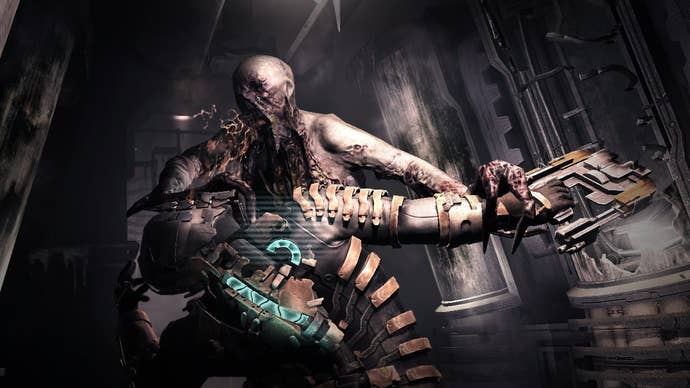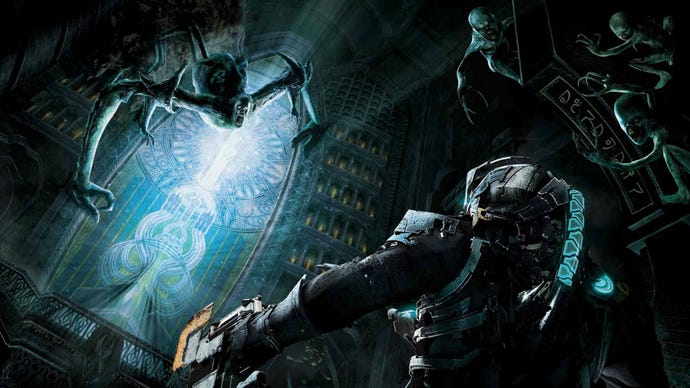Monster of the Week: The Godfather of the Necromorph on Creating Dead Space's Famous Creature
Dead Space designer Ben Wanat tells us about the creation of the Necromorphs, one of last generation's most iconic monsters.
This article first appeared on USgamer, a partner publication of VG247. Some content, such as this article, has been migrated to VG247 for posterity after USgamer's closure - but it has not been edited or further vetted by the VG247 team.
Monster of the Week is a three-part series where we dive into the creation of iconic monsters from video games with the game developers who helped bring them to life. Stay tuned for more in the weeks to come!
There are few game openings that are as simultaneously terrifying and thrilling as the start of Dead Space 2. In just its first minute, hero Isaac Clarke awakens in a straitjacket in an insane asylum, where he learns from the star of the spin-off Dead Space Ignition that the monsters of the series—Necromorphs—are at it again. Then in a flash, the man is stabbed in the skull by a Necromorph. His eyes turn white, giant insect-like legs sprout out of his back, his neck shoots up like a giraffe, and finally, his face morphs into a ghastly beast. Poor Clarke has been asleep for so long, and this is what he wakes up to.
Necromorphs are revolting, as we see in the opening's frantic escape. The monsters are a dash of Alien's Facehuggers, sprinkled in with what you might expect from a gruesome zombie movie. The transformed humans drop from the ceiling and pop out from unexpected spaces. It's exhilarating, and refreshes not just players of the first game about what they're up against, but introduces the monsters to new players as well. The Necromorphs have in their decade-plus in the video game canon claimed a corner of their own, not just in the realm of video game horror, but all horror. You never forget the first Necromorph you see, nor the last.
That's why it's surprising to hear Necromorphs creator Ben Wanat, production designer on the first two Dead Space games and creative director on Dead Space 3, tell me that Necromorphs weren't even a day-one idea for the spaceship-bound survival horror. They were a happy accident.

"It was pretty wide open in the beginning. We hadn't even settled on what the threat was. It was like, all right, it's going to be science fiction, it's going to be horror. But what? That leaves a lot of possibilities," says Wanat. The team explored the idea of killer robots, but the idea didn't quite stick. "We really wanted something organic, and we didn't think robots would be scary enough." Eventually, they were influenced by the monsters in System Shock, and from there on, the idea of an infection being the source of the threat stuck like the flu. It wasn't the sole inspiration though.
During development, the team's attention was drawn by another action-horror game: the now-legendary Resident Evil 4 and its spiky Regenerators, pitchfork-sharpening villagers, and parasites. "We were looking at that and really amazed at a lot of the creature design, and they were taking a lot of cues from what we were also looking at, which was John Carpenter's The Thing," says Wanat. "Think about science fiction movies that really are scary, and that John Carpenter movie is really kind of one of the quintessential, okay, now that is some really messed up stuff going on with the creatures there."
The early concept art work for Necromorphs, which Wanat keeps catalogued on his ArtStation portfolio, is even more gnarly than what made it into Dead Space. Now billed as the godfather of the Necromorph, Wanat tells me that the origins of the monsters' name wasn't even decided from the start. In fact, it came as a light suggestion from someone outside Visceral Games entirely.

"We had a proper name for them, and it was part of the mythology. It was the sort of thing you would just never tell the players, but it was like the thing they had on the books. It just didn't sound scary and it didn't sound like, you couldn't really relate what it was just by hearing the term," says Wanat. "So it was actually my wife [who] coined the term Necromorph, because she was looking at the design, like, 'I don't know what to call these things; [...] they're made out of dead bodies and they're alien forms. So, you know, Necromorph, why not?' So it stuck. People internally were like, 'Oh that could work, yeah, why not.' So that's kind of how the name came to be."
Though the term "Necromorphs" is firmly established in the gaming lexicon, the word is hardly ever used in game. According to Wanat, this was a conscious decision, because when said out loud, it frankly sounds silly. "It's not like you're getting attacked and your limbs are getting hacked off of your friends and you're like, 'Everybody stay away from the—what are they going to call these things... Necromorphs! Stay away from the Necromorphs!' You know, it's just ridiculous."
Throughout the series, the Necromorphs changed. They got uglier. Nastier. In Dead Space 2's case, they grew even more disturbing. The Pack, for instance, are children who were attacked and transformed into Necromorphs. In Dead Space 3, the monsters were even mummified, as they'd lain dormant for hundreds of years. The evolution of the Necromorphs came not just from Wanat, but from how the team expanded with Dead Space 2 onward. "Getting other artists into the mix, you get new ideas and on top of that new entity types that need to be created per iteration and they'll have to evolve," says Wanat. "And what is interesting based on the settings is that we could take each setting and use that as sort of the flavor for each iteration of the Necromorphs, and that influences all of the designs obviously."
There are a lot of memorable Necromorphs, like the aforementioned child victims of the space station outbreak, to the Divider, the tall gangly monster that uses its tongue to choke you so that it can replace your head with, well, their own head. "That just was such a cool, bizarre but uniquely Necromorphy sort of thing that they could do," says Wanat.
Of course, not every favorite design made the cut. After all, these games were made largely in the early parts of this past decade, when we were still in the PlayStation 3 and Xbox 360 console generation.
"We had one that was called the Tentacle Slinger where it was two of 'em combined together and they had really long tails. So it looked like a creature that had two kind of ropey tentacle arms, and it would swing from the ceiling," explains Wanat. The sound of that alone reminds me of some bosses from Resident Evil 4. "And then when you shot it down, dismembered parts of it, it would split apart onto the floor and try to flank you, basically. These two almost like twins, you know, would communicate with one another and try to take you down. I thought it was really a kind of fun visual idea, and how it transforms is so dramatic that if we could have realized it, I think it would have been a really fun enemy to fight against and just to behold coming at you from down a corridor."
It's been over a decade since the first Dead Space, nearly nine years since Dead Space 2, and five since the more action-driven Dead Space 3. In 2017, Visceral Games was shuttered by EA. Its many employees, such as Amy Hennig who was working on its now-defunct Star Wars project Ragtag, scattered to various other endeavors. Wanat himself left Visceral of his own volition in 2014 after 11 years with the studio. Currently, he's a senior creative director at Sledgehammer Games.

"It was really a great experience," he says of his time working on Dead Space. "It was just wonderful to be able to just pour yourself into an idea and then just iterate on it until you hit on something that everyone's, you know, pointing at and nodding their head and going, 'yeah, that's the one. That's what we should do.' So that was really exciting. And, like I said, I love making creatures, and so kind of everything I've worked on, and probably ever do work on, is always creature based. There's just something about the otherworldly entities and just the fantastical nature of them, and just trying to make them as real and grounded and believable as possible."
Dead Space has lived on in fans' memories over the decade. A lot of that can be credited to the horrifying levels of Necromorphs that Wanat and other artists at Visceral Games designed over the years. Wanat just hopes the monsters' legacy can carry on for another decade, or more.
"The fear that [Necromorphs] instilled; I just hope that they were unique enough, you know, that they kind of can stand the test of time," says Wanat. "That people will remember kind of how they felt about them; what they looked like. You just kind of want them to linger in people's memories, and that's enough. And that they scared the crap out of you."
- Monster of the Week, Part Two: How Amnesia: The Dark Descent's Water Lurker Became the Scariest Nautical Nightmare Since Jaws
- Monster of the Week, Part Three: How Resident Evil 2's Tyrant Got Even More Terrifying in the Remake


